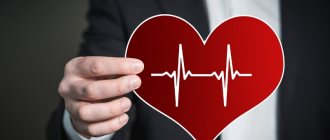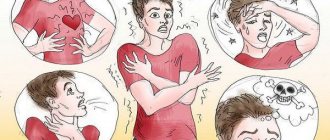Often we are faced with poor health and try to understand what is the cause of this condition. And when many laboratory and instrumental tests have already been carried out and nothing has been found, we think: “What could this be connected with? Because I really feel bad.” If there are no organ damage, it’s time to consult a neurologist. Autonomic dystonia syndrome, autonomic failure, autonomic crises are neurological diseases that we will touch on in this article.
Autonomic dystonia syndrome
Autonomic dystonia syndrome is all forms of disturbance of autonomic regulation, most often secondary manifestations of various pathologies.
There are 3 forms of SVD:
- psychovegetative – a feeling of tightness in the chest, changes in heartbeat, stomach pain, frequent vomiting, headache, dizziness, neuralgia of various locations, problems with urination, increased sweating, changes in the menstrual cycle, feeling cold;
- peripheral autonomic failure syndrome - (see autonomic failure);
- angiotrophalgic - vascular (marbling of the skin, redness, pallor, cyanosis, feeling of numbness, tingling), trophic (peeling and thinning of the skin, spots of pigmentation or depigmentation, ulcers, more often in the area of the hands and feet, brittle nails) and painful manifestations (paroxysmal prolonged pain , having a shooting, aching, burning, tingling, etc. character.
Clinical manifestations
Vascular crises have specific symptoms. In people suffering from VSD, attacks often depend on individual characteristics.
Neurotic vegetative crises are characterized by the absence of stereotypical construction. Their duration may vary. They are often of a mixed nature and are associated with emotional overstrain.
In total, experts distinguish 3 variants of attacks. Their symptoms are different. The variability of symptoms is based on the pathophysiological mechanisms that underlie the development of crises.
Manifestations of vegetative-vascular dysfunction are based on:
- disruption of the activity of certain departments of the ANS;
- hyperactivity of the sympathetic division of the ANS;
- hyperactivity of the parasympathetic division of the ANS.
Cardiac symptoms
An attack of VSD is characterized by:
- Arrhythmias.
- Changes in heart rate.
- Cardialgia.
Heart rates can either decrease or increase. The strong fear that arises against this background is combined with panic attacks. The person is afraid that “the heart will break” or “stop.”
Hypotensive symptoms
Attacks of vegetative vascular dystonia differ:
- A sharp decrease in blood pressure.
- Slowing down the heart rate.
- Lethargy, weakness.
- Frequent dizziness.
- Pain syndrome in the abdomen.
- Nausea.
- Pain in the chest.
Sometimes there are attacks of suffocation during VSD. Some patients experience shortness of breath.
Blood pressure readings range from 80 to 90/50 mmHg. Heart contractions slow down to 40-45 beats/60 seconds.
Hypertensive symptoms
The crisis of vegetative vascular dystonia is characterized by:
- Increased body temperature.
- Headaches.
- Increased heart rate.
- A sharp increase in systolic blood pressure.
Body temperature increases to 39 degrees. Headaches are quite painful. They often have a pulsating character. Heart contractions increase to 110-140 beats/60 sec. Systolic blood pressure rises to 140-180 mmHg.
Other symptoms
Vegetative-vascular paroxysms deserve special attention. There are crises:
- sympathetic-adrenal;
- vagoinsular;
- mixed.
In the first case, the VSD crisis is characterized by a rise in blood pressure. This condition is combined with headaches and heart pain, tachycardia, and trembling of the whole body. A person is haunted by a strong fear of imminent inevitable death.
In the second case, blood pressure decreases and an attack of suffocation occurs. There is a disorder of the gastrointestinal tract. The man sweats a lot and feels dizzy. Sometimes there are fainting spells.
In the third case, there is an alternation of these symptoms. Neurovegetative crisis is characterized by accelerated urination.
The cause of paroxysms may be a brain or skull injury.
Autonomic failure
Autonomic failure is a syndrome associated with impaired innervation of internal organs, blood vessels and endo- and exocrine glands.
In most cases, it is a progressive autonomic failure. In turn, MNV includes primary violations:
- idiopathic orthostatic hypotension;
- some hereditary and acquired diseases of the nervous system (multiple system atrophy, hereditary sensory-vegetative polyneuropathy)
Secondary violations include:
- for endocrine system disorders (diabetes mellitus, thyroid disease);
- for systemic and autoimmune diseases;
- for metabolic disorders;
- with paraneoplastic syndrome;
- for infectious diseases (HIV, leprosy, herpetic infections, etc.).
Various symptoms may occur:
- from the cardiovascular system: tachycardia at rest, orthostatic fainting, arterial hypertension in the supine position;
- from the respiratory system: sleep apnea, involuntary attacks of suffocation;
- from sweating: hypo- and anhidrosis, increased sweating;
- from the gastrointestinal tract: constipation, diarrhea, nausea, vomiting, anorexia;
- from the urinary system: urinary disorders, erectile dysfunction.
Diagnosis of this disease is carried out by physical examination, checking neurological status and drug tests.
Complications and prognosis
In the majority of cases, an involuntary attack is not limited to one moment; for this reason, the patient creates a stable expectation of a subsequent crisis, creating a restless situation. Patients with crisis experience the following difficulties:
- Phobias – a person seeks to avoid these places and situations that may cause an attack.
- Depression - prolonged anticipation of a new attack negatively affects a single psycho-emotional background.
- Increased fatigue and decreased social activity are also considered complications of panic attacks.
The prognosis of the disease is positive if the patient does not delay the visit to the doctor, undergoes a multifaceted examination and receives additional support from a psychotherapist.
Vegetative crisis
Autonomic crisis (panic attack) is a series of clinical manifestations characteristic of emotional disorders and disorders of the autonomic nervous system, depending on the predominance of sympathetic and/or parasympathetic innervation. The obligatory presence of anxiety, a feeling of fear (even fear for one’s life), although there is no visible threat, fear of going crazy, harming loved ones or oneself.
Vegetative crises are divided into:
- hyperventilation crisis - rapid breathing, feeling of lack of air, difficulty breathing. Fear of loss of consciousness or death. There is also tension in the muscles of the forearm and hand, legs and feet. It is important to note that the attack may end in fainting
; - vagotonic crisis - rapid heartbeat, difficulty breathing, sweating, arterial hypotension, redness of the facial skin, disruption of the gastrointestinal tract, and can also result in fainting. A crisis can be provoked by being in a stuffy room, during fasting, intense exercise, or anxiety;
- mixed crises combine the above symptoms, which can appear in turn.
It is important to carry out differential diagnosis with somatic diseases: hypo-, hyperthyroidism, diabetes mellitus, pheochromocytoma, heart rhythm and conduction disorders, gastritis, peptic ulcer, epilepsy, neuroendocrine tumors.
How to help someone suffering from vegetative-vascular crises
Treatment of vegetative-vascular crises is always symptomatic. They rarely last more than five minutes. A person needs to provide a flow of fresh air, as well as peace of mind. During exacerbations, it is necessary to avoid excessive physical activity and try not to be nervous.
To prevent such crises from recurring, it is very important to establish optimal sleep, work and rest patterns. It is useful to do gymnastic exercises. It is important to stop drinking alcohol and smoking. The patient needs to establish a diet with a predominance of fresh fruits and vegetables.
Paroxysmal and permanent autonomic disorders in the sleep-wake cycle. Kotova O.V.
Oksana Mikhailovna Drapkina , professor, doctor of medical sciences:
- Let's move on to neurology. Kotova Olga Vladimirovna: “Paroxysmal and permanent autonomic disorders in the sleep-wake cycle.”
Olga Vladimirovna Kotova , associate professor, candidate of medical sciences:
- Dear colleagues. I want to introduce myself first. I represent the Sechenov First Medical University, I work in the laboratory of pathology of the autonomic nervous system, previously it was called the department of pathology of the nervous system. This department was founded and led for a long time by Academician Wayne, who also worked a lot on sleep. The connection “sleep - autonomic disorders” was our topic, our laboratory, and remains this topic.
At the beginning of the lecture I wanted to present you with such a clinical example. A 62-year-old woman with type 2 diabetes mellitus, suffering for more than ten years, whose sugar levels fluctuate and then normalize, arterial hypertension, coronary artery disease (I think this is a fairly trivial example at an appointment with a therapist), who, among her complaints related to feeling unwell, says she is not sleeping well. And when they start to find out how long she has been sleeping poorly, it turns out that she has been sleeping poorly for the last six months. When we begin to find out the reasons why she sleeps poorly, it turns out that at one time she privatized an apartment with her husband, daughter and grandson, and assigned her shares to her daughter and grandson. Now she had a fight with her daughter, and her daughter told her six months ago: “I will evict you” - since then she has stopped sleeping normally. It is unlikely that this condition is related to her diabetes or her physical poor health. I would like to immediately draw attention: we find out the reasons, we find out that trigger mechanism, that factor that makes our patient say that he sleeps poorly. Because daytime wakefulness, our state during the day, reflects our state at night.
There are studies in which approximately eight thousand respondents took part, although this was conducted in 1989, but is still very relevant today. All respondents have some kind of mental disorder. 40% of these patients have insomnia, and 46% have extreme sleepiness. And there is even a combination that the patient does not sleep at night - he sleeps during the day, accordingly, he disrupts night sleep even more, and in general the entire sleep-wake cycle is disrupted. And only 16% of patients have no complaints about sleep. Therefore, we can conclude that people with persistent insomnia are at risk of developing depression or anxiety disorders. That is, these are the disorders that the therapist most often sees at his appointment, without calling them such disorders, but at least one can suspect it. According to other data, two thirds of patients with mood disorders have difficulty sleeping.
If we talk about anxiety, the most common condition, anxiety is normal, physiological, and this is our defense mechanism. We see some kind of danger, in particular a dog - we must collect ourselves and run away from this dog. To do this, our blood pressure increases, our muscles begin to work, and we run away. But if this dog is not there, if this danger is not there, then anxiety develops into pathological anxiety. What it is? This is a groundless, vague excitement, a premonition of danger, an impending catastrophe, a fearful expectation of something, but the patient cannot say what. This is not associated with a real threat and may be perceived as pointless concern. This is all amplified by an inadequate situation, due to internal reasons, but, naturally, we can always find some external provoking circumstance. And this is always combined with motor restlessness and autonomic reactions. Everything that I described, the patient may not tell us, and we must actively find out.
What is autonomic dystonia syndrome? The syndrome that is very often diagnosed in both very young and very elderly people. This is primarily a functional disorder of the nervous system, which is characterized by a deterioration in the general condition and well-being of a person. And this always leads to a decrease in the quality of life, and is manifested by inorganic dysfunction of various organs and systems. We see this most clearly in young patients. When, for example, a young woman comes and begins to complain about interruptions in her heart function and lack of air. We are trying to give her some kind of therapeutic diagnosis, and we do not find any organic changes.
Pathological anxiety is, unfortunately, the lot of general practitioners. And general practitioners in 40% of cases can only see anxiety disorders and another 30% are anxiety and depression. It is very important to identify this. Anxiety disorders are very often combined with sleep disorders. If we talk about the USA, then this is 10-40% of the population who complain about sleep.
A few words about vegetative dystonia. Doctors, always remember that this is not a uniform condition. Academician Wayne always urged you not to call everything vegetative dystonia. These are three large blocks: angiotrophoalgic syndrome, progressive autonomic failure and psychovegetative syndrome - the syndrome that is most often discussed. And when a therapist diagnoses vegetative dystonia syndrome, most often we mean psycho-vegetative syndrome.
How does vegetative behavior manifest itself in this syndrome? A wide variety of symptoms, and they can be associated with a wide variety of organs and systems. If we talk about the cardiovascular system, these could be cardiology, blood pressure fluctuations, acrocyanosis, rhythm disturbances. If we talk about the respiratory system, then hyperventilation syndrome is most often represented in this system. If we talk about the gastrointestinal system, then these are dyspepsia, abdominalgia, dyskinetic disorders. If there is thermoregulation, then this is low-grade fever, hyperhidrosis, chills. If we are talking about the vestibular system, then a person may complain of dizziness, instability, or some kind of vestibular disorders. Genitourinary system – frequent urination, cystalgia, and decreased libido, up to impotence in men. If we talk about movement disorders, our patients usually don’t talk about it, but we either see it ourselves, we see fussiness, tremors. In other cases, our patients say that they cannot relax, they are tormented by muscle tension and pain. And very often such patients come to see a neurologist and complain that their back hurts and their head hurts. Upon examination, we begin to detect hypertonicity in the muscles of the corresponding localization. And not only the localization that the patient presents to us. He says, I have a headache or neck pain - we begin to touch the muscles of the forearms, thighs, lower legs and there we also find very pronounced muscle tension.
What mental and behavioral symptoms of anxiety can we identify? These are irritability, impatience, a feeling of being on edge, being on the verge of a breakdown, tension, and stiffness. Our patient may experience rapid fatigue, anxiety over trifles, inability to concentrate and memory deterioration, inability to relax, and naturally, difficulty falling asleep and disturbed nighttime sleep.
How is anxiety combined with sleep disorders? In 70% of cases, sleep disorders occur simultaneously with the development of anxiety. In 15% - following the onset of an anxiety disorder. More often, presomnia disorders are detected, that is, disorders before the initiation of sleep in the form of difficulty in starting to fall asleep. The process of falling asleep can take up to two hours or more. The formation of pathological “bedtime rituals”, “fear of bed”, “fear of non-occurrence of sleep” may occur, which further aggravates the non-occurrence of this very sleep. And, unfortunately, our patients very often do not perceive a two-hour lack of sleep as an abnormal condition, because they most often have been living in this state for many months and have forgotten how it can be different, how you can fall asleep in the 10-15 minutes that are allotted for the normal process of falling asleep.
In another case, anxiety contributes to the development of insomnia. That is, a person is anxious, anxious thoughts haunt him, and he cannot fall asleep. On the other hand, people who suffer from insomnia tend to have higher levels of anxiety, initially high levels of anxiety, than people without sleep disorders.
Of course, a very common combination of two affective states is anxiety and depression. What do they lead to and what do we actually see with the combination of anxiety and depression? The course of somatic diseases worsens, and diagnosis of morbidity becomes difficult. Somatic diseases can be provoked, that is, diseases can be initiated. Contact with the doctor is deteriorating. The patient's compliance and adherence to prescribed therapy is significantly reduced. And this, in general, increases the frequency of visits to internists.
If we talk about a panic attack, this is a peak of anxiety that a person can feel. Most often, when visiting a therapist, our patient says: “My blood pressure is rising.” In any case, you should always ask: “Why did you decide that your blood pressure is rising? Why do you associate your poor condition with increased blood pressure?” The patient usually cannot verbalize his feelings himself, and we have to ask. Here are the 13 features of the DSM-IV, which is the American classification of psychiatric disorders that we should ask about. If we have four or more symptoms associated with increased blood pressure, we can say that it was a panic attack. Moreover, if we are talking about fairly young people who have never complained about pressure before and have never controlled it.
Subtypes of panic attacks. Based on many epidemiological studies and twin studies, two subtypes of panic attacks have been identified. The first are panic attacks, which are characterized by general somatic symptoms. The second are panic attacks, where respiratory disorders predominate in the picture of the attack.
It must be said that with this type of respiratory panic attack, our patients very often come to a therapist, then to a pulmonologist. They undergo an examination of the respiratory system, find some very nonspecific disorders, and, unfortunately, such patients, quite young, are often diagnosed with bronchial asthma, which results in the prescription of hormonal drugs, on which we have no effect, because these drugs are not capable of stop a panic attack. And in the future, we see, in addition to the fact that we did not treat panic attacks, also addiction to hormonal drugs, that is, additional pharmacological problems.
What are the characteristics of respiratory panic attacks? They are more likely to have a family history of panic disorder. They have a lower level of comorbidity with depression, that is, depression is detected very often in them. Usually these are longer-term illnesses, because, I emphasize again, the correct diagnosis is not immediately made. This is a more severe course of the disease, unfortunately. This is a large number of spontaneous panic attacks, that is, unprovoked panic attacks, and a better response to antidepressants if there is a respiratory subtype of panic attacks.
If we talk about hyperventilation syndrome and panic attacks. Individuals with idiopathic hyperventilation have significantly higher anxiety and depression scores than healthy controls. And, in fact, this is the cause of panic attacks. That is, idiopathic hyperventilation occurs, there is a higher level of anxiety - as a result, sooner or later a panic attack occurs.
Origin of common symptoms in acute hyperventilation and panic disorder. Patients with panic disorder suffer from episodes of chronic hyperventilation. They have hypocapnic alkalosis. This induces acute hyperventilation, and as a result we develop a panic attack.
With panic attacks and hyperventilation syndrome, the same symptoms occur, in particular: shortness of breath, palpitations, tremor, paresthesia, dizziness. Hyperventilation syndrome occurs in 40% of patients with panic disorder. And provocative hyperventilation tests, specifically 30 breaths per minute for four minutes, provoke the same panic attacks as in patients with panic disorder, that is, in patients with hyperventilation.
If we talk about panic disorder or panic attacks and sleep disorders. Our patients very often have insomnia, sleep paralysis, hypnagogic hallucinations, somnambulism and nightmares.
If we talk only about nighttime panic attacks, then they occur in up to 70% of cases, if the patient has panic attacks at all. Then this is generally a very difficult differential diagnostic task, because if something happens at night, it always frightens the patient extremely, and he wants to figure out what is happening to him.
If we talk about sleep again, then patients with nocturnal panic attacks have indicators of total power on polysomnography that are significantly higher during NREM sleep. Higher total power of low-frequency oscillations during REM sleep, and decreased sleep efficiency and a reduction in stage 4 sleep compared to healthy individuals.
But other studies have not revealed significant differences in sleep architecture between patients with daytime panic attacks, and there are, in general, nonspecific sleep disorders that can be identified not only in panic disorder.
A few words about the differential diagnosis of epileptic seizures and panic attacks. It would seem, for a therapist, what is epilepsy and why should it worry? I can tell you that panic attacks occur in 5% of the population, and epilepsy has a lifetime incidence rate of 3% of the population. That is, quite a lot of patients have both epilepsy and panic attacks. And the saddest thing is that very often these two conditions are combined. In 60% of cases, epilepsy is represented by simple or complex focal seizures, that is, not classic seizures when a person falls, loses consciousness, has convulsions, foams at the mouth, and so on. And, unfortunately, very often doctors say: “You don’t fall, you don’t lose consciousness, what kind of epilepsy do you have?” But there are attacks when the picture of a seizure is dominated by fear and autonomic disorders, and there is either no loss of consciousness at all, or it is extremely short-lived. Witnesses either do not pay attention to this or do not even know what to pay attention to. Therefore, we must question our patients extremely carefully about whether they are losing consciousness or not.
The next slide provides differential diagnostic criteria for panic attacks and epileptic seizures according to Thompson. The first is the short duration of the attacks. Anything that is short, lasting one or two minutes, should always alert us to epileptic paroxysms. The presence of motor automatisms, which are more often noticed by witnesses - these can be swallowing movements, chewing, fiddling with clothes, and a vacant gaze. The onset of the disease is more often after 45 years. There may be a history of febrile seizures and an insufficient response to a trial of treatment for panic attacks.
There are several cases described in the literature, I came across such sources, when patients allegedly with panic disorder were treated for decades with antidepressants and tranquilizers - they did not get any effect. And only with very long-term monitoring of electroencephalograms was it possible to detect the presence of epiactivity in the brain. Then they called and provoked these paroxysms, and saw changes specific to epilepsy on the electroencephalogram, and, in fact, made the correct diagnosis and began to treat such patients correctly.
What is epilepsy? This is also a vegetative crisis. How does hemodynamics change in epilepsy? First, fluctuations in the level of cerebral blood flow velocity in the middle cerebral artery increase. Patients with epilepsy are significantly more likely to have strokes. The variability of blood pressure and heart rate increases in patients with epilepsy compared to healthy people during an orthostatic test. The existence of an epileptic generator, unfortunately, makes it possible to form a disintegration syndrome, which is clinically manifested by cardiovascular disorders. We have seen patients who first begin to have some kind of cardiac attack, a heart attack, and it all ends with a generalized tonic-clonic classic attack.
Returning to affective disorders, if we talk about anxiety disorders, I would like to mention generalized anxiety disorder. This is a disorder that was identified not so long ago and attention began to be paid to it not so long ago. It is characterized by excessive and uncontrollable worry about one's health, loved ones, personal worries, financial problems and one's own future.
Epidemiology of GAD. Approximately 3% to 5% of the population may become affected during their lifetime. The age of onset is usually before 25 years. I’ll even say more, more often it’s generally children’s age. Women are more susceptible to the disease than men. If we talk about children, children generally are not given this diagnosis at all. They are diagnosed with vegetative dystonia syndrome, and such patients are also not managed correctly. And, already growing up, they come to adult neurologists with their childhood problems. The risk of chronicity of the process is very high. The course is complicated by comorbid disorders - up to 90% of cases also include panic disorder, agoraphobia, social phobias, major depressive disorder, and dysthymia. And about two-thirds of patients are at risk of relapse within a year.
According to other data, in the USA the incidence is 30%. The 12-month prevalence rate is 18%. The cost of treating anxiety disorders (again in the US) amounted to $42 billion in 1990.
What are these costs associated with? Firstly, these are direct costs: hospitalization, calling an ambulance, prescription drugs, and a huge number of consultations with doctors who cannot give the patient their diagnosis: gastroenterological, cardiological, and so on. Indirect costs include absenteeism from work, school, decreased productivity, unemployment, substance abuse, drug addiction, and even suicide.
You are presented with the DSM-IV criteria. This condition must have lasted six months or more, and three or more of the following symptoms presented on this slide must have occurred. Including sleep disturbance, please pay attention to this.
Here are the criteria according to ICD-10, encrypted with the letter F, and accordingly, this is a psychiatric diagnosis. But usually our patients say that they will not go to a psychiatrist because they do not feel they have a mental disorder, and internists, neurologists, and therapists are forced to treat such patients.
Speaking of sleep, 70% of patients with generalized anxiety disorder complain of sleep disturbances, so this is a reason to include insomnia in the list of main symptoms of an anxiety disorder, and patients have both difficulty falling asleep and frequent awakenings during the night.
With polysomnography, we identify nonspecific disorders. And polysomnography itself is extremely rarely done for generalized anxiety disorder. This is a very expensive procedure, which is why it is actually not done almost anywhere. It’s not so much about expensive equipment, but rather a very labor-intensive process, because the room is occupied for the whole day, and the doctor is in charge. The doctor must describe all this, decipher everything correctly. Medical staff must connect a huge number of sensors. But if we talk about the clinic, a positive correlation has been established between the level of anxiety and the number of awakenings. And if we don’t talk about just sleep disorders, but talk about sleep apnea syndrome, then, in general, the gold standard is polysomnography, because there are absolutely clear polysomnographic criteria.
If we talk about pharmacotherapy for anxiety disorders, antidepressants come first: these are SSRIs (selective serotonin reuptake inhibitors), serotonin and norepinephrine reuptake inhibitors; tricyclic, tetracyclic antidepressants; antipsychotics, anticonvulsants, and so on, up to antihistamines. But we must always remember that many psychotropic drugs, which our therapists, unfortunately, do not really like to prescribe, and which are used to treat anxiety, can cause sleep disorders or aggravate existing sleep disorders.
According to Western literature, cognitive behavioral therapy is recognized as more effective methods, and it comes first, and then only sleeping pills, in very short courses, if insomnia occurs.
I would like to present to you one longitudinal study (from 2003 to 2007, 10 thousand patients). Patients with generalized anxiety disorder were prescribed SSRIs in almost 50% of cases, serotonin and norepinephrine inhibitors in 6%, and benzodiazepines in 34%. Benzodiazepines were the initial treatment in one third of patients. The average duration was about a month. But one in five patients starting treatment with benzodiazepines remained on treatment for more than 90 days. And I think that this is not a discovery at all for your practice either. Our patients become accustomed to benzodiazepines and consider them a panacea.
This study examined healthcare costs in the year before diagnosis of generalized anxiety disorder and in the year after diagnosis. Please note that preliminary expenses amounted to five thousand dollars, and subsequent expenses amounted to seven thousand dollars. The increase in this money was directly related to pharmacotherapy in only 18% of cases, and everything else is an exacerbation of existing diseases, or the discovery of some new diseases, or the search for these new internal diseases. Because the patient usually doesn’t stop: “I have pain, let’s find why I have pain. And it doesn’t matter to me how many examinations you give me.”
If we talk about anxiety disorders and insomnia (also data from foreign literature), the most commonly used drugs are Trazodone and Mirtazapine (antidepressants) and benzodiazepines. Actually, benzodiazepines were the standard treatment for insomnia for about 20 years, and were a common method of treatment, including anxiety disorders.
I think that you all know about all the disadvantages of benzodiazepines - I want to remind you again. High risk of dependence and sedation, increased risk of industrial and road traffic injuries; neonatal and infant mortality when used in late pregnancy; A significant proportion of patients receiving benzodiazepines are at risk of increased anxiety after discontinuation of such therapy. If we are talking about elderly patients and long-term use, then there is a risk of developing addiction, cognitive deficits, and an increase in the frequency of falls in older people. That is, these are already such global problems.
What's the alternative? If there is insomnia in anxiety disorders, let's use sleeping pills very briefly, no more than five days, and preferably three days, and explain to patients that we need to review sleep hygiene, that is, how we treat this sleep. If we talk about sleeping pills, I would like to tell you about Donormil - it is doxylamine succinate, a histamine receptor blocker. It has a hypnotic, sedative and M-anticholinergic effect. It is very important that it has a sedative effect - that is, having anxiety, the patient can calm down a little more when taking the drug. The drug is available in tablets of 15 milligrams. And what is very important, it not only increases the duration and improves the quality of sleep, but also does not disrupt the physiological phases of normal sleep and circadian rhythms. The severity of its sedative effect is comparable to barbiturates, that is, quite high. Has relative contraindications in relation to sleep apnea. And as we have already said, we do not detect these apneas, that is, we do not register them, so we can only make assumptions and must use more or less safe sleeping pills. No addiction or dependence. The use of the drug is not accompanied by deterioration of cognitive function, and it can be used throughout the entire period of pregnancy. In particular, doxylamine is very actively used in Western literature for the treatment of toxicosis in the first half of pregnancy.
Principles to be followed in case of sleep disorders. Firstly, this is the prescription of medications during the day with their maximum concentration immediately before bedtime and the regulation of the functional states of the brain. If we prescribe a tranquilizer at night, we reduce the severity of emotional-vegetative reactions, especially in the REM sleep phase, when various cardiovascular accidents most often occur. And if we are talking about wakefulness, then we must maintain a long-term state of relaxed wakefulness, and not anxious wakefulness, which, in fact, helps to improve sleep.
Let me finish here. Thank you for your attention.
Which doctor should I see and what tests should I take?
For help in treating new-onset vegetative-vascular dystonia, you should contact a neurologist. But if vegetative symptoms recur periodically, then you need to visit a therapist to undergo a comprehensive examination, since this doctor can refer the patient to the necessary specialist.
The main types of research for vascular dystonia syndrome are:
- Measuring blood pressure at different time intervals;
- Carrying out EchoCG and ECG;
- X-ray of the chest in 2 projections;
- MRI of the brain, chest and peritoneum;
- Determination of blood glucose;
- Determination of catecholamines in urine and blood.
General picture of the disorder
The main symptom of the disorder is the appearance of somatic symptoms affecting one or more organ systems.
The pathological manifestations are multiple, reminiscent of the clinical picture of a separate disease, but are characterized by blurriness, uncertainty, and rapid variability. A peculiarity of the presentation of complaints by patients is a special dramatism. Patients present symptoms emotionally vividly, exaggeratedly, using all kinds of epithets. They visit a huge number of doctors of various specialties and require examinations. When examinations refute the presence of physical pathology, the patient resists this news, is confident in the examination’s error and continues further vigorous diagnostic and treatment activities. Patients often spend years on “treatment” before a correct diagnosis is made.
Such people are quite sensitive to their own feelings, tend to exaggerate them, and often call an ambulance and are hospitalized. Numerous examinations and ineffective treatment fuel patients’ confidence in the presence of the disease. This situation causes distrust in individual specialists and medicine itself.
Kinds
Fears can be different: fear of falling, fear of crowds, fear of open spaces. The vegetative crisis lasts within 20–40 minutes. According to severity they are divided into:
- Lungs. Lasts 10–15 minutes. Up to two symptoms are present.
- Average. Lasts from 15 minutes to 1 hour. The state of health worsens and the person may faint.
- Heavy. Lasts from 1 hour. They interfere with living fully. You will most likely need medical attention.
There are regional and systemic vascular crises. The differences are that with regional ones there is a disruption of the blood supply in a certain part of the body. The consequences of such a crisis are migraines and Raynaud's disease. Symptoms of systemic vascular crises: increased or decreased blood pressure.
What causes severe crises
The root causes of such exacerbations are not yet fully understood. However, numerous studies and diagnostic results have made it possible to establish what may be the cause of the vegetative crisis:
- Hormonal imbalance and genetic predisposition;
- Long-term use of potent medications, stress, psycho-emotional imbalance;
- Endocrine disorders;
- Central nervous system disorders.
Often domestic violence and other social causes lead to an aggravation of a person’s condition, the first symptoms of a vegetative crisis.
Prevention
There are no specific preventive measures to avoid the development of the disease. But you can help the body cope with the onset of attacks faster. First of all, doctors recommend leading a healthy lifestyle. Drinking alcohol can further aggravate attacks and also increase their frequency.
During the interictal period, you will need to take folk remedies with a sedative effect. These can be tinctures of valerian, peony, motherwort. Regular visits to a psychotherapist will help build stress resistance. Various psychotherapeutic techniques help improve the patient’s mental state and help get rid of developed phobias.
With a strong desire, it is possible to cope with panic attacks. But this will require strict adherence to medical recommendations. Timely treatment is a serious step towards recovery.
Did you like the article? Save it!
Still have questions? Ask them in the comments! Cardiologist Mariam Harutyunyan will answer them.
Ivan Grekhov
Graduated from the Ural State Medical University with a degree in General Medicine. General practitioner
Vestibular consequences
Most clinically reported cases of vegetative crisis are not limited to a single attack. The patient remembers for a long time the sensations from the symptoms he experienced, and his further life activities are fixated on anxious anticipation. This behavior reinforces repetition, provoking behavioral restrictions, forcing a person to avoid dangerous situations.
The patient has depressive disorders, and vestibular consequences include the following symptoms:
- Frequent dizziness;
- Increased fatigue;
- Decreased activity.
Important! Competent and timely therapy leaves no room for negative symptoms of a vegetative crisis.
A vegetative crisis has a lot of unpleasant symptoms and requires immediate treatment. You should understand what a vegetative crisis is and try to maintain control over yourself when unwanted symptoms occur.
Diagnostics
Diagnosis of a vegetative crisis, as a rule, does not cause difficulties. First of all, the doctor excludes diseases of the endocrine and nervous systems, and somatic disorders. Further diagnosis occurs according to the following criteria:
- type of attack and its duration;
- presence of emotional and affective states;
- presence of autonomic disorders;
- the presence of a provoking factor.
The diagnosis is made after excluding the following diseases: bronchial asthma, schizophrenia, depression, heart problems, epilepsy and brain diseases.
Next, the doctor measures blood pressure, blood samples are taken for biochemical and detailed tests, and a laboratory urine test is performed. A referral is given for ECG, echocardiography, Doppler of the cervical spine and head vessels. Sometimes an MRI is required.
There are minor crises when less than four symptoms are present, and extensive crises when more than four symptoms occur.
Treatment
In this matter, timely consultation with a doctor is of great importance. Based on the test results, comprehensive treatment is prescribed, including medication, psychotherapy and psychosocial treatment.
Important! Most often, treatment includes the use of psychotropic and sedative medications.
If an attack occurs, it is recommended to immediately take sedative herbal medicines. During pregnancy, a doctor's permission is required. If attacks are accompanied by low blood pressure, lethargy and weakness, a course of eleutherococcus and ginseng is prescribed. If you feel worse, give a Relanium tablet to chew.
Important! It is necessary to dispel the patient's fear of the existence of a life-threatening disease.
After identifying the cause of dystonia, treatment is prescribed by a doctor according to the profile of the underlying disease (allergist, psychologist, endocrinologist).
Traditional medicine recommends drinking infusions of hawthorn, motherwort, valerian, peony, and eating bananas and nuts. If necessary, electrophoresis and massage are prescribed.
But not all medications provide a long-term effect, since they temporarily block an attack without curing the psychological problem. Along with drug therapy, it is necessary to engage in psychological therapy. It is recommended to consult a psychologist who will competently diagnose and help get rid of the disease.
Signs and symptoms of the disease
If a person suffers from vegetative crises, frequent attacks are characterized by certain symptoms.
Anxiety, isolation, conscious avoidance of social life and other people, fear of death, frequent mental breakdowns are clear signs of a specific disease.
A sudden release of adrenaline into the bloodstream leads to the following symptoms:
- Tremor of the limbs;
- A distinct lack of oxygen;
- Increased heart rate;
- Increased anxiety, agitated state;
- Excessive sweating, increased body temperature followed by chills;
- Sudden weakness, sudden dizziness;
- Loss of consciousness;
- Feeling of pain in the left side of the sternum;
- Strong headache.
Any panic attack is a serious stress for the body. Autonomous crises do not disappear without a trace. The person begins to fear another attack, worries and again experiences very unpleasant sensations.
Mixed and hysteroid crises
Mixed crisis - characterized by a combination of the above symptoms.
Hysterical (fainting-tetanic) crisis - characterized by tachycardia, hysterical hyperventilation, increased blood pressure, tremor and local convulsions, but there may also be generalized tetany.
Emergency care for mixed and hysteroid crisis
- Inject intravenously or intramuscularly 0.5% seduxen solution 0.05 ml-0.1 ml/kg, but not more than 2.0 ml.
- In case of incomplete relief of a convulsive state, administer 20% sodium hydroxybutyrate solution 0.25-0.5 ml/kg intravenously.











